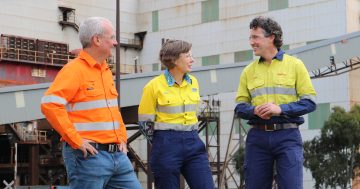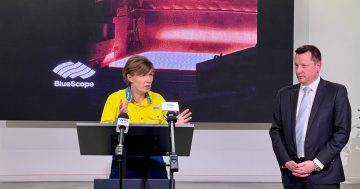
Artist’s impression of BlueScope’s proposed multi-industrial precinct. Photos: BlueScope.
A parcel of BlueScope’s Port Kembla Steelworks – larger in size than the Melbourne CBD – will be transformed into a multi-industrial precinct and a potential “super TAFE”.
BlueScope on Monday night (20 November) unveiled a master plan to develop 200 ha of non-steelmaking excess land adjacent to the steelworks.
Developed after 18 months of research, analysis and community engagement, the master plan will see BlueScope transform the surplus land into a next-generation multi-industrial precinct with potential to create 30,000 jobs in emerging industries such as clean energy and defence.
The company believes the precinct could employ as many people as it did during the heyday of the steelworks.
BlueScope managing director and CEO Mark Vassella said it would be “one of the most significant land transformation and job creation opportunities in Australia”.
The company also announced it had signed a memorandum of understanding (MoU) with TAFE NSW to explore the opportunity for a “super TAFE” on the site.
BlueScope engaged Denmark’s Bjarke Ingels Group (BIG), a global leader in urban design and architecture of industrial sites, to craft a “new urban model” for the land.
The project meets BlueScope’s First Nation’s Framework, recognising Country and aiming to retain more than 60 per cent of the transformed site as green and blue space and open parklands.
“As we fast approach our 100-year anniversary of steelmaking here in Port Kembla, we are acutely aware of the cultural and historical significance of this site, one of the largest manufacturing sites in Australia,” Mr Vassella said.
“Our plan is to retain approximately 70 per cent of the existing building floorspace to preserve this important steelmaking heritage.
“We already have around $2 billion of capital investment manufacturing projects planned or underway in Port Kembla, and now with the release of the Master Plan, it’s absolutely true to say there has never been a more exciting time for BlueScope and the Illawarra.
“Our urban planners, BIG often remind us of the global scale of this opportunity. They also remind us how unique the opportunity is given we own the land, it’s just over an hour from Sydney, is adjacent to Australia’s largest manufacturing site, has access to a deep sea port, and the local transport infrastructure includes a six-lane highway and four train stations within its boundary.”
Mr Vassella said preliminary economic modelling by Deloitte suggested the master plan could generate an additional 20,000 jobs and contribute up to $5 billion annually to the gross regional product.







“This would see BlueScope’s economic contribution in NSW double from 1 per cent to 2 per cent of gross state product,” he said.
“Our flag on the hill over the coming decades is to see 30,000 people working on this site in all sorts of new industries and services.”
Over the next six months, BlueScope and NSW TAFE will work together to explore the concept of the super TAFE and to develop a business case that will analyse all aspects of the opportunity.
“We are delighted to be working with TAFE NSW to explore this opportunity. They share our vision for ensuring continued growth in opportunities that support people looking to build their careers in the Illawarra region,” Mr Vassella said.
“According to a community survey by Reptrak in April 2023, 86 per cent of the Illawarra community agree this is a significant opportunity for the region.”
“The research also identified that new jobs in clean energy, education, training, and tech and research should be the focus. Crucially, this aligns well with the Master Plan vision,” he added.
“While the Master Plan has been revealed, now the real work starts! This includes further community consultation, conducting commercial analysis on how this long-term development play could be structured and financed, as well as addressing streamlined planning approval frameworks, and determining infrastructure requirements.
“As the master plan unfolds, BlueScope looks forward to continued collaboration with stakeholders, the community, and government bodies to bring this transformative vision to life.”
In August, the company announced it would spend $1.15 billion to reline the No 6 blast furnace, believed to be Australia’s largest ever steel infrastructure project.
It said the reline would provide the company with a bridge until new technology was developed that would allow commercially viable low emission steelmaking.
The reline is expected to create up to 300 new jobs during construction.
















